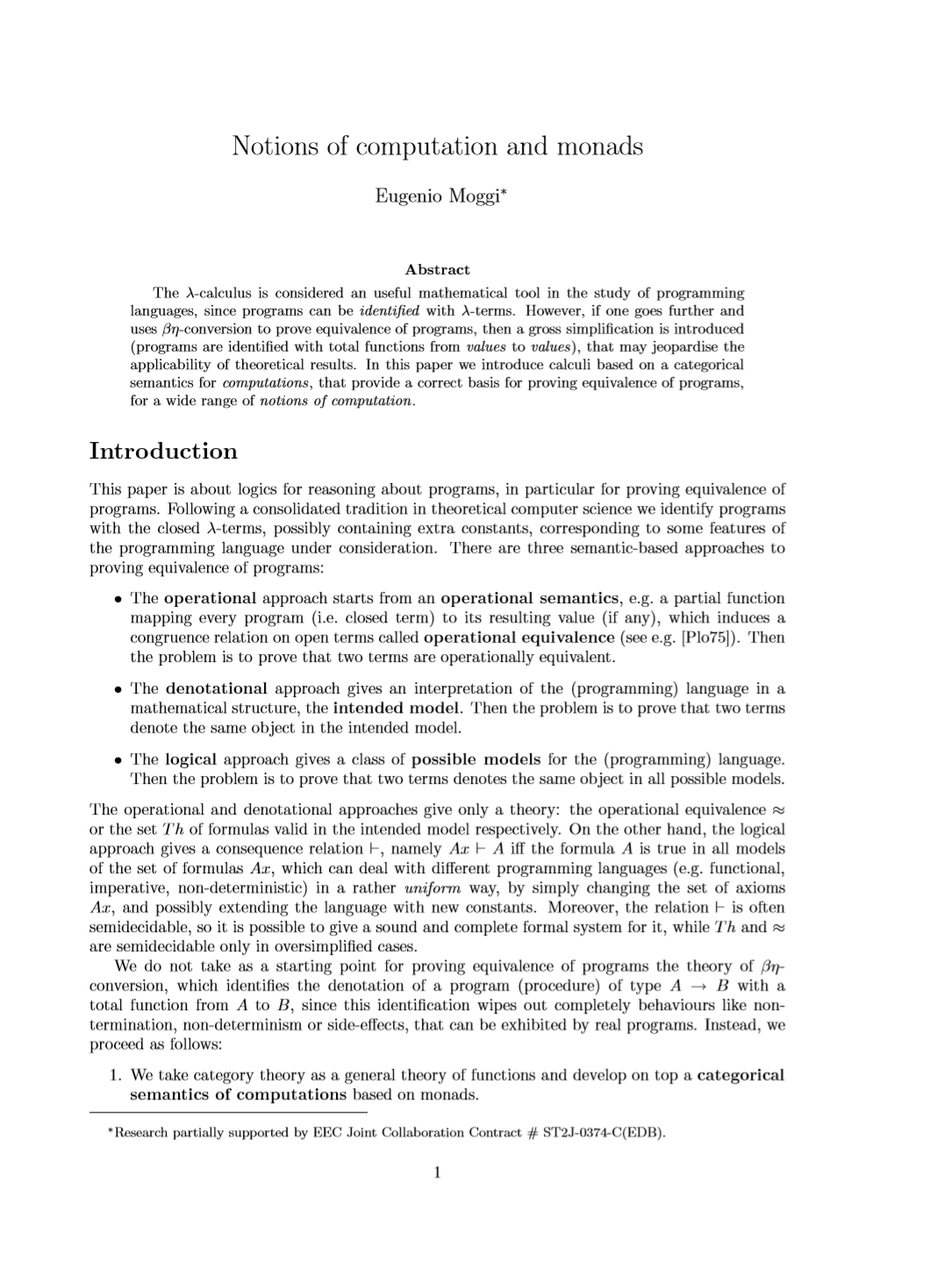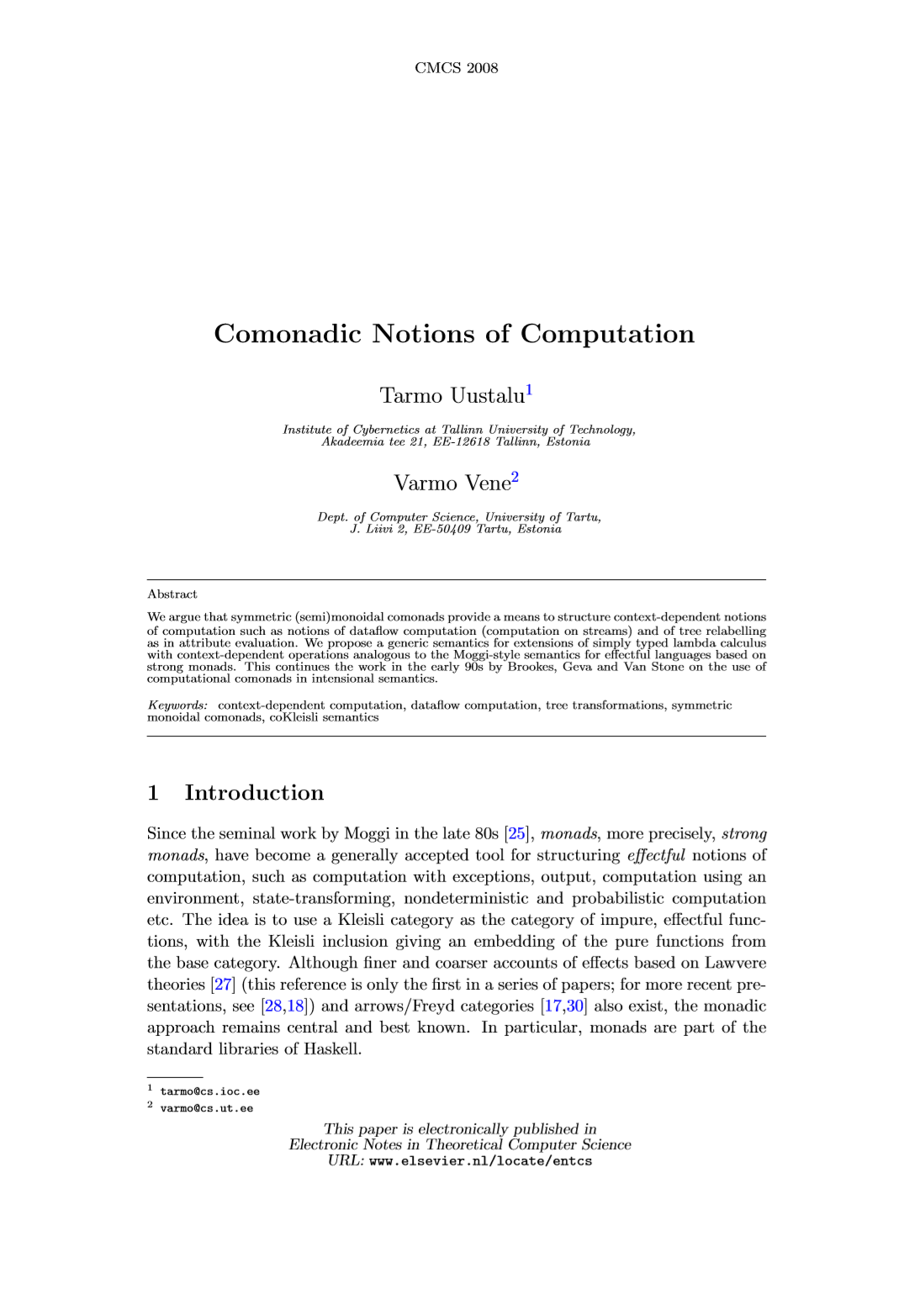type Maybe<'a> =
| OK of 'a
| Fail
Full name: index.Maybe<_>
union case Maybe.OK: 'a -> Maybe<'a>
union case Maybe.Fail: Maybe<'a>
Multiple items
val unit : v:'a -> Maybe<'a>
Full name: index.unit
--------------------
type unit = Unit
Full name: Microsoft.FSharp.Core.unit
val v : 'a
val bind : f:('a -> Maybe<'b>) -> mv:Maybe<'a> -> Maybe<'b>
Full name: index.bind
val f : ('a -> Maybe<'b>)
val mv : Maybe<'a>
Multiple items
module List
from Microsoft.FSharp.Collections
--------------------
type List<'a> = 'a list
Full name: index.List<_>
type 'T list = List<'T>
Full name: Microsoft.FSharp.Collections.list<_>
Multiple items
val unit : v:'a -> 'a list
Full name: index.unit
--------------------
type unit = Unit
Full name: Microsoft.FSharp.Core.unit
val bind : f:('T -> #seq<'b>) -> mv:List<'T> -> 'b list
Full name: index.bind
val f : ('T -> #seq<'b>)
val mv : List<'T>
val v : 'T
val r : 'b
type Prod<'a> = Map<string,string> * 'a
Full name: index.Prod<_>
Multiple items
module Map
from Microsoft.FSharp.Collections
--------------------
type Map<'Key,'Value (requires comparison)> =
interface IEnumerable
interface IComparable
interface IEnumerable<KeyValuePair<'Key,'Value>>
interface ICollection<KeyValuePair<'Key,'Value>>
interface IDictionary<'Key,'Value>
new : elements:seq<'Key * 'Value> -> Map<'Key,'Value>
member Add : key:'Key * value:'Value -> Map<'Key,'Value>
member ContainsKey : key:'Key -> bool
override Equals : obj -> bool
member Remove : key:'Key -> Map<'Key,'Value>
...
Full name: Microsoft.FSharp.Collections.Map<_,_>
--------------------
new : elements:seq<'Key * 'Value> -> Map<'Key,'Value>
Multiple items
val string : value:'T -> string
Full name: Microsoft.FSharp.Core.Operators.string
--------------------
type string = System.String
Full name: Microsoft.FSharp.Core.string
val counit : Map<string,string> * 'a -> 'a
Full name: index.counit
val cv : Prod<'a>
val snd : tuple:('T1 * 'T2) -> 'T2
Full name: Microsoft.FSharp.Core.Operators.snd
val cobind : f:(Prod<'a> -> 'b) -> Map<string,string> * 'a -> Prod<'b>
Full name: index.cobind
val f : (Prod<'a> -> 'b)
val res : 'b
val fst : tuple:('T1 * 'T2) -> 'T1
Full name: Microsoft.FSharp.Core.Operators.fst
type Hist<'a> = 'a * 'a list
Full name: index.Hist<_>
val counit : 'a * 'a list -> 'a
Full name: index.counit
val v : Hist<'a>
val cobind : f:(Hist<'a> -> 'b) -> 'a * 'a list -> Hist<'b>
Full name: index.cobind
val f : (Hist<'a> -> 'b)
val cv : Hist<'a>
val x : 'a
val xs : 'a list
val rs : 'b list
The deal with category theory
Just a collection of mathematical structures!
- Very general and very rich...
- But you don't always need category theory
Algebra and program design
A monoid \((S, \bullet, \epsilon)\) is a set \(S\) with an element \(\epsilon \in S\)
and an operation \(\bullet : S\times S \rightarrow S\) satisfying:
Unit element
\(\forall a \in S\) it holds that \(a \bullet \epsilon = a = \epsilon \bullet a\)
Associativity
\(\forall a, b, c \in S\) it holds that \((a \bullet b) \bullet c = a \bullet (b \bullet c)\)
Monoids and programming
Standard - well-known structures
- Numbers (\(+\) with zero, \(\ast\) with one)
- Lists (concatenation, empty list)
Fancier - dictionaries with word counts
\[\forall w . (d_1 \bullet d_2)[w] = d_1[w] + d_2[w] \\
\forall w . \epsilon[w] = 0\]
Why are monoids useful?
You get useful properties for free!
Say you want to calculate:
\[r = a_1 \bullet \ldots \bullet a_n\]
Monoids guarantee that \(r = r_1 + r_2\) where
\[r_1 = \epsilon \bullet a_1 \bullet \ldots \bullet a_{n/2} \\
r_2 = \epsilon \bullet a_{n/2+1} \bullet \ldots \bullet a_{n}\]
We just invented word count with map-reduce!
Semantics and category theory

Monads, comonads and category theory
This paper is about logics for reasoning about programs,
in particular for proving equivalence of programs.
This is not about programming, but about program semantics!
- What programs are equivalent?
- What does a program actually denote?
- Do some useful program properties hold?
Semantics of programming languages
Operational semantics
Reduction relation: \(e_1 \rightarrow e_2\)
Denotational semantics
Interpretation of terms: \([\![ e ]\!] = \,?\)
Category = objects + arrows
A category \(C\) consists of objects \(obj(C)\) and arrows \(arr(C)\) between objects, i.e.
\(f : A \rightarrow B\) where \(A, B \in obj(C)\) with:
Arrow composition
Given \(f : A \rightarrow B, g : B \rightarrow C\), there is \(f\circ g:A \rightarrow C\).
Associativity
Given \(f, g, h\), it holds that \((f\circ g)\circ h = f\circ (g\circ h)\)
Identity arrow for all \(B\)
\(id_B : B \rightarrow B\) such that \(id_B \circ f = f\) and \(g \circ id_B = g\)
Interesting categories
Standard mathematical structures
- Sets or spaces with functions
- Numbers with arrows from smaller to larger
Categories in programming langauges
- Types and functions between them
- Classes with inheritance arrows
Category of types and functions
\[\begin{xy}
\xymatrix{
\text{int}\times\text{int} \ar@/^/[r]^{~~~fst} \ar@/_/[r]_{~~~snd} & \text{int} \ar[r]_{zero} & \text{bool}
}
\end{xy}\]
This is a valid category
- Identity arrows: \(id_A = \lambda (x:A) \rightarrow A\)
- \(\circ\) is (associative) function composition
Functors between categories
Given categories \(C\) and \(D\) a functor \(F\) from \(C\) to \(D\) associates:
- Objects \(A\in obj(C)\) with \(F(A) \in obj(D)\)
- Arrows \(f:A \rightarrow B\) with
\(F(f) : F(A) \rightarrow F(B)\)
(also must preserve identities and composition)
Functors between types
Turns category of types and functions into other types and functions between them
\[\begin{xy}
\xymatrix{
\text{int}\times\text{int} \ar@/^/[r]^{~~~fst} \ar@/_/[r]_{~~~snd} \ar@{.>}[d]_{list} &
\text{int} \ar@{.>}[d]_{list} \ar[r]_{zero} & \text{bool} \ar@{.>}[d]_{list} \\
(\text{int}\times\text{int})~\text{list} \ar@/^/[r]^{~~~map~fst} \ar@/_/[r]_{~~~map~snd} &
\text{int}~\text{list} \ar[r]_{map~zero} & \text{bool}~\text{list}
}
\end{xy}\]
Category theory wrap-up
Just a very general algebraic structure!
- Objects with arrows between them
- Functors between categories
Why people like and use cateogry theory?
- Lots of explored structures we can steal
- Close functional programming analogy
- ...and it makes you sound smarter!
Categorical approach to semantics

Categorical approach to semantics
What is the meaning of a + b?
\[a:\text{int}, b:\text{int} \vdash a + b : \text{int}\]
Arrow or morphism between two objects:
\[\text{int}\times\text{int} \rightarrow \text{int}\]
Yes, you can read this as a function too...
Categorical approach to semantics
What is the meaning of e?
\[v_1:\tau_1, \ldots, v_n:\tau_n \vdash e : \tau\]
Arrow or morphism between two objects:
\[\tau_1\times\ldots\times\tau_n \rightarrow \tau\]
Maps product of inputs to the output
Simple categorical semantics
Variable access
\[[\![ v : \tau \vdash v : \tau ]\!] = id_\tau\]
Composition with let binding
\[[\![ v_0 : \tau_0 \vdash \text{let}~v_1=e_1~\text{in}~e_2 : \tau_2 ]\!] = \\
[\![ v_1 : \tau_1 \vdash e_2 : \tau_2 ]\!] \circ [\![ v_0 : \tau_0 \vdash e_1 : \tau_1 ]\!]\]
(Slightly cheating here - no variable scoping!)
Monads and comonads

Monadic and comonadic semantics
Interpret expression as morphism with some more structure:
\[\definecolor{mc}{RGB}{0,32,172}
\definecolor{cc}{RGB}{172,0,32}
\definecolor{mcl}{RGB}{128,150,250}
\definecolor{ccl}{RGB}{250,128,150}
v_1:\tau_1, \ldots, v_n:\tau_n \vdash e : \tau\]
Wrap output in monad \({\color{mc} M}\) or input in comonad \({\color{cc} C}\):
\[\tau_1\times\ldots\times\tau_n \rightarrow {\color{mc} M}(\tau) \\
{\color{cc} C}(\tau_1\times\ldots\times\tau_n) \rightarrow \tau\]
(Tricky thing - the comonad is over the variable context!)
Monadic notions of computation
Given a category \(C\), a monad is a functor \({\color{mc} M} : C \rightarrow C\)
together with mappings (or natural transformations):
\(\eta_\tau : \tau \rightarrow {\color{mc} M}(\tau)\)
\((-)^*\) which turns an arrow \(f : \tau_1 \rightarrow {\color{mc} M}(\tau_2)\)
into an arrow \(f^* : {\color{mc} M}(\tau_1) \rightarrow {\color{mc} M}(\tau_2)\)
What are monads good for?
Given \(\tau_1\) produce \(\tau_2\) wrapped in some additional structure.
\(\tau_1 \rightarrow {\color{mcl} M}(\tau_2)\)
- Can produce no results (failure, exception)
- Can produce multiple results (non-determinism)
- Can produce results & something else (logging)
The maybe monad
Models partial computations: \({\color{mc} M}~\alpha = \alpha + \{\bot\}\)
1:
2:
3:
4:
5:
6:
7:
8:
9:
|
// A value 'a or a value representing failure
type Maybe<'a> = | OK of 'a | Fail
// Creates a successful computation
let unit v = OK(v)
// Propagates failure through a computation
let bind f mv = match mv with
| OK(v) -> f(v)
| Fail -> Fail
|
The list monad
Models non-deterministic computation: \({\color{mc} M}~\alpha = \mathcal{P}(\alpha)\)
1:
2:
3:
4:
5:
6:
7:
8:
9:
|
// Using standard functional list..
type List<'a> = 'a list
// Creates result with just one value
let unit v = [v]
// Collects results for all possible inputs
let bind f (mv:List<'T>) =
[ for v in mv do
for r in f(v) do yield r ]
|
Monadic categorical semantics
Uses monad operations to get: \(\tau_1 \times \ldots \times \tau_n \rightarrow {\color{mc} M}(\tau)\)
Variable access uses unit:
\[[\![ v : \tau \vdash v : \tau ]\!] = \eta_\tau\]
Monadic categorical semantics
Composition uses bind written as \((-)^*\):
\[[\![ v_0 : \tau_0 \vdash \text{let}~v_1=e_1~\text{in}~e_2 : \tau_2 ]\!] = \\
[\![ v_1 : \tau_1 \vdash e_2 : \tau_2 ]\!]^* \circ [\![ v_0 : \tau_0 \vdash e_1 : \tau_1 ]\!]\]
How does this work?
\[[\![ v_0 : \tau_0 \vdash e_1 : \tau_1 ]\!] : \tau_0 \rightarrow {\color{mc} M}(\tau_1) \\
[\![ v_1 : \tau_1 \vdash e_2 : \tau_2 ]\!] : \tau_1 \rightarrow {\color{mc} M}(\tau_2) \\
[\![ v_1 : \tau_1 \vdash e_2 : \tau_2 ]\!]^* : {\color{mc} M}(\tau_1) \rightarrow {\color{mc} M}(\tau_2)\]
Monadic notions of computation
Given a category \(C\), a comonad is a functor \({\color{cc} C} : C \rightarrow C\)
together with mappings (or natural transformations):
\(\mu_\tau : {\color{cc} C}(\tau) \rightarrow \tau\)
\((-)^*\) which turns an arrow \(f : {\color{cc} C}(\tau_1) \rightarrow \tau_2\)
into an arrow \(f^* : {\color{cc} C}(\tau_1) \rightarrow {\color{cc} M}(\tau_2)\)
Comonadic categorical semantics
Uses comonad operations to get: \({\color{cc} C}(\tau_1 \times \ldots \times \tau_n) \rightarrow \tau\)
Variable access uses counit written as \(\mu_\tau\):
\[[\![ v : \tau \vdash v : \tau ]\!] = \mu_\tau\]
Composition uses cobind written as \((-)^*\):
\[[\![ v_0 : \tau_0 \vdash \text{let}~v_1=e_1~\text{in}~e_2 : \tau_2 ]\!] = \\
[\![ v_1 : \tau_1 \vdash e_2 : \tau_2 ]\!]^* \circ [\![ v_0 : \tau_0 \vdash e_1 : \tau_1 ]\!]\]
What are comonads good for?
Given \(\tau_1\) with some additional structure produce \(\tau_2\).
\({\color{ccl} C}(\tau_1) \rightarrow \tau_2\)
- Can take additional values (resources, parameters)
- Can take multiple inputs (historical values)
- Can take structured inputs (say, 2D grid)
The product comonad
Models additional parameters: \({\color{cc} C}~\alpha = \phi \times \alpha\)
1:
2:
3:
4:
5:
6:
7:
8:
9:
|
// Pair value with e.g. a "hidden dictionary"
type Prod<'a> = Map<string, string> * 'a
// Access the value and ignore the dictionary
let counit (cv:Prod<'a>) = snd cv
// Propagate the hidden dictionary without changing it
let cobind f (cv:Prod<'a>) : Prod<'b> =
let res = f cv
(fst cv, res)
|
The list comonad
Keeps a current value with a list of past values
Compute: \(f(x) = x + \text{prev}(x)\)
\(f : {\color{cm} C}(\text{int}) \rightarrow \text{int}\)
The list comonad
Keeps a current value with a list of past values
Compute: \(f(x) = x + \text{prev}(x)\)
\(f* : {\color{cm} C}(\text{int}) \rightarrow {\color{cm} C}(\text{int})\)
The list comonad
Value with zero or more past values: \({\color{cc} C}~\alpha = \alpha \times (\text{List}~\alpha)\)
1:
2:
3:
4:
5:
6:
7:
8:
9:
10:
|
// Current value with list of historical
type Hist<'a> = 'a * list<'a>
// Access the current value
let counit (v:Hist<'a>) = fst v
// Apply on current & previous elements (recursively)
let rec cobind f (cv:Hist<'a>) : Hist<'b> =
(f cv), ( match snd cv with
| x::xs -> let r,rs = cobind f (x, xs) in r::rs
| [] -> [] )
|
Grid computations with comonads
Average value and its neighbours
| 0.0 | 1.0 | 1.0 |
| 0.0 | 2.0 | 2.0 |
| 2.0 | 3.0 | 4.0 |
|
|
Grid computations with comonads
Average value and its neighbours
| 0.0 | 1.0 | 1.0 |
| 0.0 | 2.0 | 2.0 |
| 2.0 | 3.0 | 4.0 |
|
|
Compute averages!
Summary

Summary
Monadic computations: \(~\tau_1 \rightarrow {\color{mc} M}(\tau_2)\)
- Return value with some non-standard aspect
- No value (failure), more values (non-determinism), logging
Comonadic computations: \(~{\color{cc} C}(\tau_1) \rightarrow \tau_2\)
- Take inputs with some non-standard aspect
- Hidden parameters, history, neighborhood
Summary
Why is category theory useful?
- Lots of structures we can steal
- Like programming, focuses on composition
- Not a sacred cow! Use it when it solves a problem!
Why nobody knows about comonads?
- Monads were first and are more useful
- Creating
codo notation is harder



